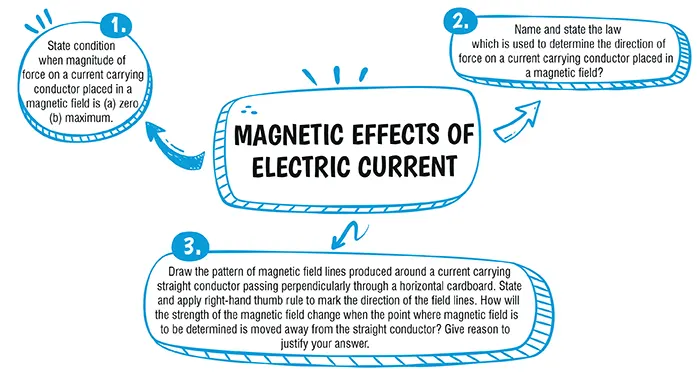Table of Contents

Ans. (d)
Explanation:
If the current is doubled in each wire the force will be 4F. This can be explained as follows:We know that the force of repulsion per unit length between two wires carrying current in opposite direction is:
\\ \dfrac{F}{l} = \dfrac{μ_0i_1i_2}{2\pi d} \\
Thus when both i_1 \text{ and } i_2 are doubled, the force between them becomes four times.
Ans. (c)
Explanation:
\\ \text{B = µ}_0. \dfrac{N}{L}. \text{I}\\[2.5 bp]
Where:
B = magnetic field inside the solenoid (in Tesla)
μ₀ = permeability of free space = 4π×10^{−7} Wb/Am
N = number of turns in the solenoid
L = length of the solenoid (in meters)
I = current passing through the solenoid (in Amps)
Given:
N = 210 turns
L = 50 cm = 0.50 m
I = 8 A
μ₀ = 4π × 10^{−7} Wb/Am
Plug in the values into the formula:
\text{B} = \dfrac{4\pi× 10^{-7}×210×8}{0.50}\\[4.5 bp] \text{B = 422.4 × 10}^{-5} \text{ T}Explanation:
No force acts on a current carrying conductor when the current in the conductor is parallel to the magnetic field.
Maximum force is exerted on the current carrying conductor if it is perpendicular to the direction of magnetic field.
Explanation:
The direction of force on a current carrying conductor placed in a magnetic field is obtained by the Fleming’s left hand rule.
This rule states that “ When forefinger, central finger and thumb of left hand are stretched in such a way that they are mutually perpendicular to each other, if the forefinger indicates direction of magnetic field, central finger indicates the direction of current, then thumb will indicate the direction of motion of conductor i.e., force on the conductor.
Explanation:
Maxwell’s Right Hand Thumb rule states that if current carrying wire is imagined to be held in the right hand so that thumb points in the direction of current, then the direction in which fingers encircle the wire will give the direction of magnetic field lines around the wire. If we hold the current carrying straight wire so that thumbs in upward direction points the direction of current, the direction of magnetic field lines will be anticlockwise. The strength of magnetic field is inversely proportional to the distance of the point of observation from the wire. So, as we move away from the wire the strength of magnet decreases.

| Chapter No. | Chapter Name |
|---|---|
| Chapter 1 | Chemical Reactions and Equations |
| Chapter 2 | Acid, Bases and Salts |
| Chapter 3 | Metals and Non-Metals |
| Chapter 4 | Carbon and its Compounds |
| Chapter 5 | Life Processes |
| Chapter 6 | Control and Coordination |
| Chapter 7 | How do Organisms Reproduce |
| Chapter 8 | Heredity |
| Chapter 9 | Light : Reflection and Refraction |
| Chapter 10 | The Human Eye and the Colourful world |
| Chapter 11 | Electricity |
| Chapter 12 | Magnetic Effects of Electric Current |
| Chapter 13 | Our Environment |
| Chapter Wise Important Questions for CBSE Board Class 10 Science |
|---|
| Chemical Reactions and Equations |
| Acid, Bases and Salts |
| Metals and Non-Metals |
| Carbon and its Compounds |
| Life Processes |
| Control and Coordination |
| How do Organisms Reproduce |
| Heredity |
| Light : Reflection and Refraction |
| The Human Eye and the Colourful world |
| Electricity |
| Magnetic Effects of Electric Current |
| Our Environment |
CBSE Important Questions Class 10
ICSE Important Questions Class 10
CBSE Important Questions Class 10
ICSE Important Questions Class 10